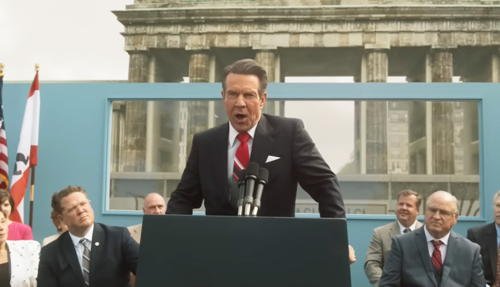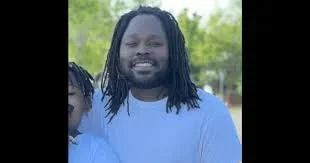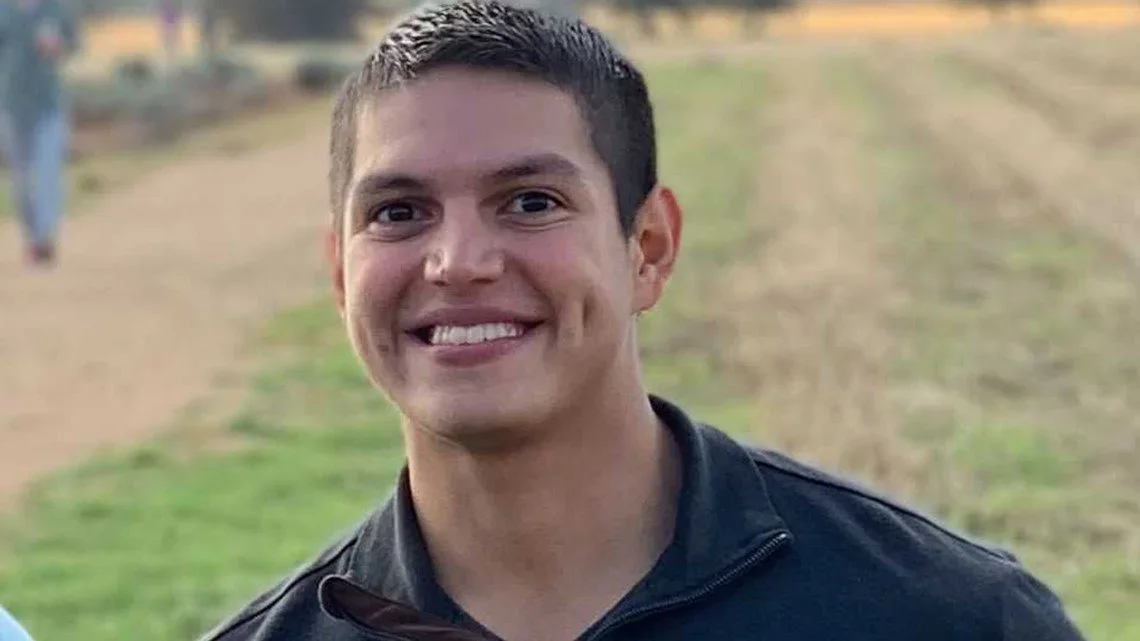Reagan: Cold War Cocktail Recipe 🥁 🥁 🥁 🥁
/Year Released; 2024
Directed by: Seam McNamara
Starring: Dennis, Quaid, Jon Voight, Penelope Ann Miller
(Pg-13, 135 min.)
Genre: Biographical Drama
“Mr. Gorbachev, tear down this wall.” Ronald Reagan in Berlin, 1987
Reagan, the man. He certainly failed as much or more than he succeeded. And he didn’t hit his stride until he was in his seventies. Love him or hate him, he left an indelible mark on America.
First of all, Dennis Quaid is excellent in playing Reagan. He does not try to imitate him, but he gets his gestures, body language, and voice down pat. It reminds me of Joaquin Phoenix playing Johnny Cash in Walk the Line. Though so different in stature and build from Cash, Phoenix captured Cash’s singing postures and facial angles at the mike completely.
The same is true with Quaid, especially when he says his most famous line, on June 12, 1987:
“Mr. Gorbachev, tear down this wall,”
a phrase he was not supposed to utter as it was too provocative, especially during the delicate years of détente. But Reagan did it anyway, and about 2 ½ years later, the West German people themselves did “tear down this wall” with little or no resistance from East Berlin. I still have a small piece of that wall that my daughter brought back on a trip there in the early nineties.
Quaid is also very good when things are not going so well. We see several scenes of his humiliation, initially with his first wife, Jane Wyman, whose career was fast eclipsing his. (Different Drummer agrees with some critics who see her portrayed a perhaps a bit too harshly here.) In the film, Ms. Wyman rubs it in, in a very public scene:
“If you put as much work into your career as you do making your speeches, you’d have an Oscar by now,” she seethes.
Reagan did make two very good films, one being Knute Rockne, All American, in 1940, where he played George Gipp, a freshmen halfback powerhouse who dies suddenly, but becomes a motivation for the team to “Win one for the Gipper.”
King’s Row (1942) was also very good, but about all we see of either film are a few old posters on his wall. Instead, we are treated to Bedtime for Bonzo from 1951, where Reagan plays second fiddle to a chimpanzee, and all the other humiliations of his now B level acting career.
In fact, when he and the then Nancy Davies fall in love, he tells her he has little to offer. He is a divorced, (then a social stigma) washed up B actor short on funds and at a dead end. But she loves him and that means everything.
***
Equally excellent is Jon Voight, who plays “a retired KGB officer assigned to keep a check on a certain actor and Union leader” giving advice to a young Russian leader– some say perhaps a young Vladimir Putin. Voight’s character is a composite, but his tales are a framing device that anchors a film that covers almost 9 decades. Early on he sees Reagan as a threat to the Soviet Union because he is a crusader.
We see flashbacks of a young bespectacled Reagan being bullied. His mother warns, “You can run from a bully for so long, but after a while you’re going to have to stand up to him.” And we see him removing his glasses and walking toward the gang of his tormentors. Pictured is young Ronald Reagan’s house in Dixon, Illinois.
Voight also sees Reagan’s early years as a lifeguard as fundamental, too. He saved 77 people from drowning in the Rock River in Dixon, Illinois, where he worked for 7 years, starting at age 16. He put in 12-hour days, 7 days a week from Memorial Day until Labor Day. He even notched up that number on an old log nearby, although, the film adds a humorous note that the handsome young Reagan also had to rescue many sweet young things who probably faked water distress so they could be carried in his arms.
The elder Reagan, however learned some valuable lessons there. “…I learned how to read the currents. Not just the ones on the surface, but also the ones deep underneath the water.” A little like Mark Twain in his riverboat captain days on the Mississippi.
During his time as president of the Screen Actors Guild, he saw it wedged between communist and mob pressure, putting himself in the middle of those malign influences. And it was in that role that he met the young actress Nancy Davies, who came to him over an identify mix-up over someone with her name, a somewhat unsavory character. They were married in 1952, and she was with him until his death in 2004.
We see Nancy at first pretending to be a horsewoman and failing completely, but that is probably the only part of Reagan’s life she could and did not share. When he campaigns for California Governor, she is right there with him going door to door. Behind one door is a smiling woman who sort of recognizes him but cannot quite remember his name. Nancy hints that his initials are RR, and the women is overjoyed that Roy Rogers in at her door.
When Reagan is shot in 1981, she forces herself into the surgery room. Both are frantic without each other.
“I forgot to duck.” he quips to Nancy, never losing his sense of humor although the bullet had punctured his lung and he was in very serious condition. “I hope you are Republicans,” he jests to the surgeons before they put him under.
Regan’s interactions with the Soviet Union are classic, too. First of all, we see a legion of older, out of touch Russian leaders, Leonid Brezhnev (1964-1982), Yuri Andropov (1982-1984), and Konstantin Chernenko (1984-1985) during his Presidency from 1980-1988. Refusing to meet with them is a power play which Reagan explains with a droll comments that he couldn’t really meet with them, since they kept dying on him. Then he even refuses the milder Mikhail Gorbachev’s (1984-1991) offer to ban all ballistic missiles in their October 1986 meeting at Reykjavik Summit in Iceland, insisting that the United States retain its right to develop SDI, (Strategic Defense Initiative) sometimes derisively called “Star Wars.”
In the film, the two leaders get off to a bad start, and then Reagan tries a little Hollywood magic. He walks out the door and reenters, saying “Take two.” Whether this really happened or not, Different drummer is not sure, but Paul Kengor, on whose 2006 book,The Crusader the film is based, is a Regan scholar, and has written several other well documented books on our 40th President. (So it may well have happened like that.)
***
The final years of Reagan are moving, too. We hear him read his letter to the American people detailing his diagnosis with Alzheimer’s disease in 1994 and get glimpses of that life of retirement on his ranch until his death 10 years later.
Perhaps the most poignant scene is when the secret service agent chosen to stay with him there, one chosen because of his ability and love of horses, confides in the staff and Nancy that it is becoming too dangerous for Regan to continue to ride. The horse senses his confusion about the terrain and without leadership, has thrown him a few times. We witness Regan’s final ride– a slow walk and then a free last gallop over the hills Rancho del Cielo near Santa Barbara, California.
Here is what the actor who played that agent said:
Donovan plays John Barletta in the movie. In an exclusive interview with Heavy, Donovan said that he filmed his part at Reagan’s ranch outside of Santa Barbara, California, where he portrayed one of Reagan’s Secret Service agents, Barletta. He said Barletta was Reagan’s equestrian detail, so he rode horses with Quaid. “I got a real emotional scene with him where I have to tell him we can’t ride horses anymore because of his mental deterioration,” Donovan shared. “It was a real emotional moment where I had to tell Ronald Reagan that we can’t do the one thing he loves to do anymore. … Which is all part of a true story about how it happened.
My only beef with the riding shown in the film is that they show Reagan riding Western. All the photos of the real Reagan riding show him riding English. That is a much greater challenge, especially if your horse is a stallion
This stallion was a gift horse from Mexican President José López Portillo in 1981. A thoroughbred-Arabian cross, El Alamein stood 16 hands tall and Reagan enjoyed the challenge this spritely stud offered him in every ride.
Here are a few real pictures of Reagan and Nancy at the ranch.
Certainly written, directed, and acted by those who admire Reagan, but worth the watch for all of us who lived through those moments in history, or for the younger crowd, for seeing what you may have missed.
A tribute to a man who led us to peace without firing a shot.
–Kathy Borich
🥁 🥁 🥁 🥁
Trailer
Film-Loving Foodie
It was the Reykjavik Summit in Iceland where Reagan and Gorbachev begin the negotiations that eventually ended the Cold War and opened the Berlin Wall a few years later. Our Cold War Cocktail, salutes the that meeting. DifferentDrummer is grateful for the Hello Cocktail Blog for this delicious blend.
In honor of this week’s Cold War-themed book review, I decided to craft two cocktails that paid homage to two key Cold War-era summits, the Helsinki Accords of 1975 and the Reykjavik Summit (that’s Iceland) in 1986. Up first was “The Icelandic Daisy” made with Icelandic Reyka vodka, yellow chartreuse, lemon juice, simple syrup, and angostura bitters. Reyka, which is filtered using spring water that runs through a lava field, is all the rage and deservedly so – I tried a bit of it neat and it’s as smooth and pleasant as promised. The cocktail itself offers a very rich, faintly sweet, beautiful taste heavy on the bitters and chartreuse. I felt it was a little overly bitter in the middle, but good lemon and sugar bookends. Worth making again. –Hello Cocktails Blog
Cold War Cocktail
· 1.5 oz Reyka Vodka
· .75 oz Yellow Chartreuse
· .75 oz lemon juice
· .5 oz sugar syrup
· 2 dashes Angostura Bitters
Pour into a chilled glass and enjoy.



























